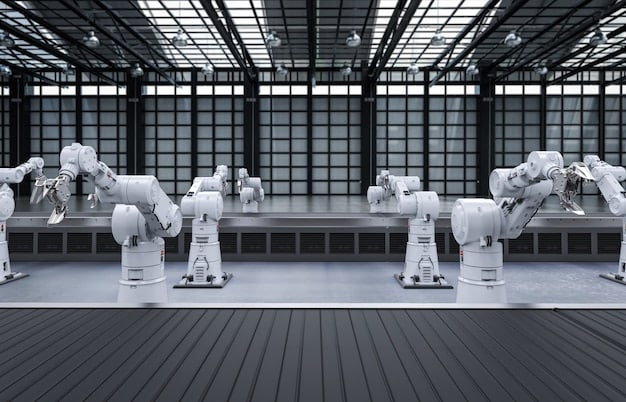Automation’s Impact on the US Job Market: Business Opportunities and Challenges

Automation is significantly reshaping the US job market, presenting both opportunities for increased productivity and innovation, as well as challenges related to job displacement and the need for workforce retraining in businesses across the United States.
The rise of automation is transforming industries across the United States, bringing both exciting opportunities and significant challenges for businesses. Understanding the nuanced impact of **automation on the US job market** is crucial for companies looking to thrive in this evolving landscape.
Understanding Automation’s Reach in the US Economy
Automation is no longer a futuristic concept; it’s a present-day reality that’s deeply interwoven into the fabric of the US economy. From manufacturing to customer service, automated systems are streamlining processes and redefining traditional job roles.
The Scope of Automation Across Industries
Automation is making inroads in diverse sectors, each experiencing unique shifts. In manufacturing, robots handle repetitive tasks, enhancing production speed. Simultaneously, in customer service, chatbots provide instant support, elevating customer experience. These changes are increasingly shaping the employment landscape in each sector.
Specific Examples of Automation Technologies
Several key technologies are driving automation. These include artificial intelligence (AI), which powers intelligent systems; robotics, which handles physical tasks; and machine learning (ML), which enables systems to improve over time. Each technology contributes uniquely to automation’s expanding impact.
- AI-driven customer service chatbots
- Robotic process automation (RPA) in finance and accounting
- Machine learning algorithms for predictive maintenance in manufacturing
The pervasive reach of automation is undeniable, altering how businesses operate and how individuals perform their jobs. By embracing technological advancements and understanding their potential, businesses can leverage automation to achieve remarkable growth.

Opportunities Created by Automation for US Businesses
While automation is often associated with job displacement, it also creates new opportunities for businesses to innovate, grow, and enhance their competitiveness. By strategically implementing automation, companies can unlock significant benefits.
Increased Productivity and Efficiency
One of the primary benefits of automation is the boost in productivity and efficiency. Automated systems can operate around the clock, performing tasks faster and more accurately than humans, leading to higher output and reduced costs.
Cost Reduction and Improved Profitability
Automation can significantly reduce operational costs by minimizing errors, lowering labor expenses, and optimizing resource utilization. This leads to improved profitability and a stronger bottom line for businesses.
Examples of Efficiency Gains
- Automated inventory management systems reducing waste by 20%
- RPA streamlining accounting processes by 30%
- AI-powered data analysis identifying cost-saving opportunities
Beyond immediate economic gains, automation offers the opportunity for businesses to realign their workforce, focusing on higher-value tasks that require creativity, critical thinking, and emotional intelligence. This shift can lead to a more engaged and productive workforce.
The Challenges Automation Poses to the US Job Market
Despite the potential benefits, automation also presents significant challenges to the US job market. Businesses must be aware of these challenges and proactively address them to ensure a smooth transition.
Job Displacement and Workforce Transition
One of the most pressing concerns is job displacement. As automation takes over routine tasks, many workers face the risk of losing their jobs, leading to unemployment and economic hardship.
The Need for Workforce Retraining and Upskilling
To mitigate job displacement, there is a critical need for workforce retraining and upskilling. Workers need to acquire new skills that align with the demands of the automated economy, focusing on areas like technology, data analysis, and creative problem-solving.
Strategies for Retraining
- Investing in employee training programs
- Partnering with vocational schools and community colleges
- Providing access to online learning resources
Automation necessitates that businesses and policymakers devise strategies to support affected workers. By investing in education, training, and alternative career pathways, we can ensure that individuals are equipped to adapt and thrive in the automated economy.

Adapting Business Strategies for an Automated Future
To navigate the changing landscape, businesses must adapt their strategies to align with the demands of an automated future. This requires a proactive approach to innovation, workforce development, and ethical considerations.
Investing in Automation Technologies
Businesses should proactively invest in automation technologies that can improve efficiency, reduce costs, and create new opportunities. This includes exploring AI, robotics, and other advanced systems.
Developing a Skilled Workforce
It’s essential to invest in workforce development programs that equip employees with the skills needed to succeed in an automated environment. This involves training employees on new technologies and fostering skills like critical thinking, communication, and problem-solving.
Examples of successful adaptation
- Manufacturing companies transitioning workers to robot maintenance roles
- Retailers training staff to manage AI-powered customer service tools
- Financial institutions upskilling analysts in data science and machine learning
Adapting to automation is a continuous process that requires ongoing innovation and a commitment to workforce development. By taking a proactive approach, businesses can harness the power of automation while ensuring a sustainable and inclusive future for all.
The Role of Government and Policy in Managing Automation
The government has a crucial role to play in managing the impact of automation on the US job market. Policies that support innovation, workforce development, and social safety nets are essential for navigating the transition.
Policy Recommendations
Several policy recommendations can help mitigate the negative effects of automation. These include investing in education and training programs, strengthening social safety nets, and promoting policies that encourage innovation and job creation.
Government Initiatives and Programs
Government initiatives such as grants for workforce retraining, tax incentives for businesses that invest in automation training, and unemployment benefits can provide crucial support to workers affected by automation.
Examples of Policy Support
- Tax credits for businesses that provide retraining programs
- Grants for community colleges to offer technology-focused courses
- Expansion of unemployment benefits for displaced workers
Proactive government policies are necessary to ensure that the benefits of automation are shared widely and that the challenges are addressed fairly. By collaborating with businesses, educational institutions, and labor organizations, policymakers can create a more resilient and inclusive economy.
Ethical Considerations in Implementing Automation
Implementing automation also raises important ethical considerations. Businesses must address issues like data privacy, algorithmic bias, and the impact on employee morale to ensure that automation is used responsibly.
Addressing Data Privacy Concerns
As automation relies heavily on data, businesses must prioritize data privacy and security. This involves implementing robust data protection measures and ensuring transparency in how data is collected, used, and stored.
Combating Algorithmic Bias
Algorithms used in automated systems can perpetuate biases if not properly designed and monitored. Businesses must take steps to identify and mitigate algorithmic bias to ensure fair and equitable outcomes.
Ethical Guidelines
- Developing clear guidelines for data collection and use
- Implementing bias detection and mitigation processes
- Engaging employees in discussions about ethical considerations
By addressing these ethical considerations proactively, businesses can build trust with employees, customers, and the broader community, fostering a more responsible and sustainable approach to automation.
| Key Point | Brief Description |
|---|---|
| 🚀 Productivity Boost | Automation increases efficiency and output in various industries. |
| ⚙️ Job Market Shift | Automation leads to job displacement but creates new opportunities requiring different skills. |
| 📚 Upskilling Imperative | Workforce retraining is crucial for adapting to automation’s demands. |
| ⚖️ Ethical Challenges | Data privacy and algorithmic bias are key ethical considerations. |
Frequently Asked Questions
▼
Automation can lead to job creation in areas such as AI development, robot maintenance, and data analysis. While some jobs may be displaced, new roles will emerge requiring different skill sets.
▼
Skills such as data analysis, programming, critical thinking, and creativity are highly valued. Employees who can adapt to new technologies and solve complex problems will be in high demand.
▼
Businesses should invest in training and upskilling programs to equip employees with the skills needed to work alongside automated systems. This includes providing access to online courses, workshops, and mentorship opportunities.
▼
Algorithmic bias occurs when automated systems perpetuate discriminatory patterns. Preventing it involves careful design, thorough testing, and continuous monitoring of algorithms to ensure fairness and equity.
▼
The government can support innovation through funding, promote workforce development through educational programs, and provide social safety nets for displaced workers. Policy support is vital for a smooth transition.
Conclusion
In conclusion, the impact of automation on the US job market presents both significant opportunities and challenges for businesses. By embracing technological advancements while proactively addressing workforce development, ethical considerations, and government policies, businesses can harness the power of automation to drive growth and create a more inclusive and sustainable economy for all.





